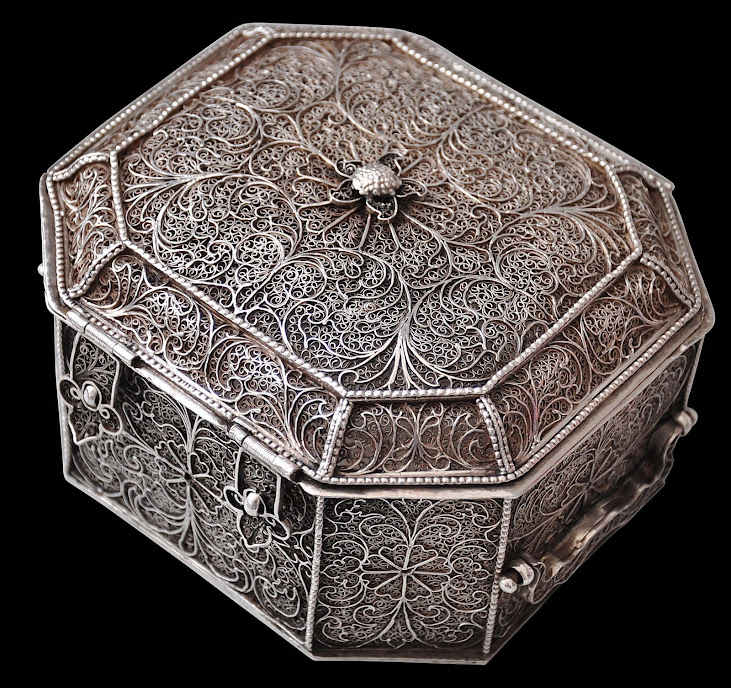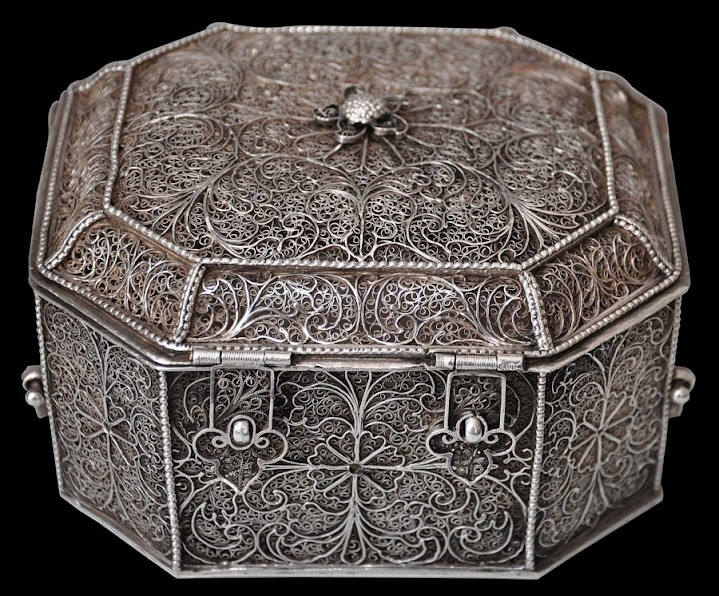Post Updated 21 October 2023.
An 18th Century Dutch Silver Filigree Box.
With unidentified cypher on the lid.
Formerly with dealer London dealer Peter Cameron.
https://petercameronantiquesilver.com/product/an-18th-century-dutch-filigree-box/
He says Dutch.
I am very grateful to Peter Cameron for allowing me to use his images.
Both of the round boxes illustrated here form part of a group of silver filigree objects where the fine double twisted silver wire elements are set back from a frame work of rectangular section silver wire.
I have posted on the subject of objects made with similar techniques
see - https://antiqueeuropeanfiligree.blogspot.com/2023/04/t-he-dullaert-art-and-antiques-17t
see several possibly related examples below.
Diam 5.8cms.
https://petercameronantiquesilver.com/product/an-18th-century-dutch-filigree-box/
.........................................................
A Possibly Related Filigree box with Unidentified Silver Gilt Cypher.
I suspect that the covering of the cypher is rock crystal.
Diameter: 12cm, height: 5.3cm.
With London Dealer Michael Backman.
I remain to be convinced of the Batavian attribution.
The following adapted from Michael Backmans website -
Michael Backman on his website suggests that the similarity
in formulation and the presence of the crown with that on the writing box of
William III in the Hermitage Collection suggests that this box also was made
for a member of the House of Orange-Nassau.
"The box is stamped with the ‘crowned V’ mark used by the
Dutch authorities between 1814-1893 as a duty mark on foreign-made silver. This
is important and adds further evidence as to the provenance of this box, ie
that it most probably was made in the colonies of Dutch East Indies.
I have attempted to conmake contact with Jan Veenendaal but have yet to hear back from him.
Refs -
Haags Gemeentemuseum, V.O.C. – Zilver: Zilver uit de periode
van de Verenigde Oostinische Compagnie 17de en 18de eeuw, 1983.
Piotrovsky, M. et al, Silver: Wonders from the East –
Filigree of the Tsars, Lund Humphries/Hermitage Amsterdam, 2006.
Tchakaloff, T.N. et al, La Route des Indes – Les Indes et
L’Europe: Echanges Artistiques et Heritage Commun 1650-1850, Somagy Editions
d’Art, 1998.
Voskuil-Groenewegen, S.M. et al, Zilver uit de tijd van de
Verenigde Oostindische Compagnie, Waanders Uitgevers, 1998.
Zandvlieyt, K. et al, The Dutch Encounter with Asia
1600-1950, Rijksmuseum Amsterdam, 2002."
Once again grateful thanks to Michael Backman for permission to use his photographs.
...................................
Illustrated below are a group of silver filigree caskets where the fine double twisted silver wire elements are set back from a frame work of rectangular section silver wire.
An Octagonal Casket formerly with London Dealer Michael Backman.
Length: 12.5cm height: 7cm, width: 11cms.
The little embossed / repousse boss on the flower in the centre of the lid appears occasionally on other (German) pieces - The Silver Gilt, Silver Filigree and Boulle work Toilet Mirror is an example. I will be posting on this mirror in due course.
The 17th/18th Century Fries Museum Silver Filigree Casket.
Included here as an example of an object made with similar techniques to the boxes illustrated above -
the smaller filigree elements set back from the rectangular elements that make up the framing.
Adapted as a tea caddy in the late 18th century.
Dutch Late 17th/ Early 18th Century.
Fries Museum, Leeuwarden, Netherlands. - From the Collection Royal Frisian Society.
Width: 10.9 cm height: 13.5 cm, length: 16.8 cms.
Bears the mark of Jan Buysen (1747 - 1813) of Amsterdam.
https://collectie.friesmuseum.nl/?diw-id=tresoar_friesmuseum_Z1939-257
For a brief biog of Buysen. see also https://rkd.nl/nl/explore/artists/358044?langen=
...............................
The Dullaert Art and Antiques 17th Century Shallow Domed Top Silver Filigree Casket or Knottekistje.
(The Traditional Dutch Wedding Casket).
Height 11.8 cms. Width 20.2 cms. Depth 15 cms.
Lined in white satin with handles on the sides.
In 1848, as reported in the study on Santa Maria di Nazareth (Tomaini P./ Rossignotti A. 1975, p. 254) the institution had to resort to a loan to pay for the new Collegiate organ , and pledge "..a small silver box worked with grain thread containing a small chalice with its paten weighing four and a half pounds". In 1852, the loan covered, the objects returned to the Collegiate.
The casket contains a silver chalice with paten (see entries nos. 14434 and 14434A).




































No comments:
Post a Comment